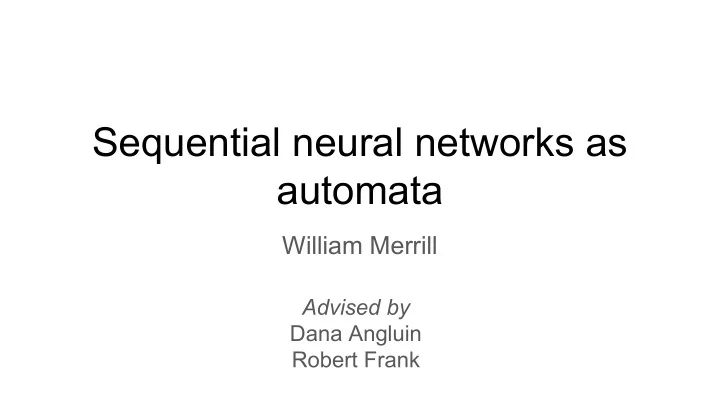

Sequential neural networks as automata William Merrill Advised by Dana Angluin Robert Frank
Neural Networks
Modern Artificial Intelligence ● Most recent advances in AI use neural networks ● Especially true for language (NLP)
What is a Neural Network? ● A network of artificial cells which send information to each other ● Learn the weights for cell connections from data 97% “cat”
Sequential Neural Networks ● For language, we use networks that can read variable-length sequences Hello world !
Interpretability of Neural Networks ● Neural networks are good at translation, classification, summarization, etc. ● But, how and why they work is still an open question ● Cell connections must encode some kind of grammar
Why is Interpretability Important? ● Guiding research ● Social accountability ● Intellectual value
My Method ● Build off of formal language theory ● Prove what kinds of linguistic structure neural networks can model
Formal Language Theory
Formal Languages ● Potentially infinite sets of valid sentences english = {“ I am Will. ”, “ I like AI! ”, ..} íslenska = {“ Ég heiti Will. ”, “ Mér líkar við gervigreind! ”, ..} palindromes = {“ aa ”, “ aba ”, “ abba ”, ..}
Automata ● Grammar/Automaton : Computational device that decides whether a sentence is in a language (says yes/no) Yes, if x is valid Sentence x Automaton No, if x is not valid
Types of Automata ● More computationally complex automata can accept more languages Turing-acceptable languages Regular Counter Context-free languages languages languages
Formal and Natural Languages ● Formal languages and automata are well studied (since 1930s) ● Formal languages model structures in natural language Neural Formal Natural Networks Languages Languages Chomsky, Parikh, etc. Turing, Church, Fischer, etc.
Research Questions 1. What kinds of formal languages can neural networks accept? 2. How do these languages relate to formal models of natural language?
My Contributions 1. Definitions a. Language acceptance for neural networks b. Measure of network’s memory 2. Results a. SRNs b. LSTMs c. Attention d. CNNs 3. Experiments
Definitions
Asymptotic Acceptance ● Networks output a probability (not yes/no) ● Need to make network say yes or no
State Complexity ● Measure of network’s memory (as function of sentence length) ● How many states can network be in after reading n words? memory = log 2 (state complexity)
Theoretical Results
Simple Recurrent Networks (SRNs) ● Simplest architecture for recurrent neural networks ● Turing-complete under unconstrained definition of acceptance (Siegelmann, 1995) Hello world !
SRNs as Automata ● Thm 2.1.2 : SRNs accept exactly the regular languages ● State complexity: O(1) (Constant) ● Reduced characterization is more accurate than Siegelmann (1995)’s ● Similar result for gated recurrent units (GRUs) TL RL
Long Short-Term Memory Networks (LSTMs) ● More complicated recurrent neural network ● Used for machine translation and other tasks requiring syntax
LSTMs as Automata ● Thm 2.2.2 : LSTMs accept a subclass of the counter languages State complexity: O(n k ) ● (Polynomial in sentence length) ● More powerful than other recurrent networks ● But not powerful enough to model complex tree structure
Attention ● Modern machine translation uses attention ● Focus on specific input words at different steps It ‘s very cold here LSTM LSTM LSTM LSTM LSTM LSTM LSTM LSTM LSTM Hace mucho frío aquí
Attention Results State complexity: 2 O(n) ● (Exponential in sentence length) ● Additional memory allows: ○ Copying a sequence (primitive translation) ○ More complex hierarchical representations ● Supports claim “attention is all you need” (Vaswani, 2017)
Convolutional Neural Networks (CNNs) ● CNNs model words at the character level ● Deal with phonology, morphology ○ pain versus pains
CNNs as Automata ● Thm 3.1.1 : CNNs accept the strictly local languages ● Explains success of character-level CNNs ● Strictly local languages* are good model of phonological grammar (Heinz et al., 2011) *Tier-based strictly local languages
State Complexity Hierarchy O(n k ) O(1) 2 O(n) CNN SRN GRU LSTM Attention
Experiments
LSTMs as Counter Automata ● Prediction: LSTMs are equivalent to counter machines ● LSTMs use memory to “count” (Weiss et al, 2018) LSTM cell values on a n b n Cell value Position in sequence
Memory Constraints of LSTMs ● Prediction: LSTMs don’t have enough memory to reverse sentences ● LSTM cannot reverse long sentences!
Validating State Complexity Counting requires O(n k ) complexity ● Copying requires 2 O(n) complexity ● Can count! O(n k ) O(1) 2 O(n) CNN SRN GRU LSTM Attention Can copy!
Summary ● Theoretical tools ○ Language acceptance ○ Formalizing memory ● Results about types of networks ● Experiments
Conclusion ● Step towards understanding the “black box” of neural networks ○ Extendable to other architectures ● Related neural networks to mental grammar ○ LSTM can’t do complex trees ○ CNN can do phonology
Acknowledgements ● My advisors, Bob and Dana ● Computational Linguistics at Yale: ○ Yiding, David, Noah, Andrew, Annie, Yong, Simon, Aarohi, Yi Chern, Sarah, Rachel ● Linguistics Senior Seminar: ○ Anelisa, James, Jay, Jisu, Magda, Noah, Rose, Hadas, Raffaella ● Advanced Natural Language Processing Seminar: ○ Michi, Suyi, Davey, John, Yavuz, Gaurav, Tianwei, Tomoe, Rui, Danny, Angus, Brian, Yong, Garrett, Noah, Alex, Talley, Ishita, Bo, Jack, Tao, Yi Chern, Irene, Drago ● Vidur Joshi and others @ Allen Institute for Artificial Intelligence
Recommend
More recommend